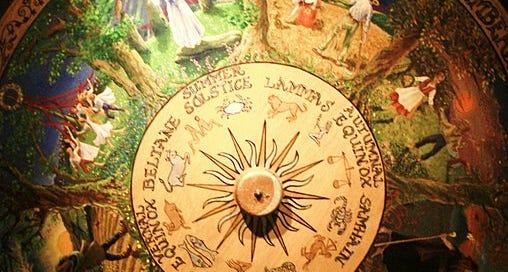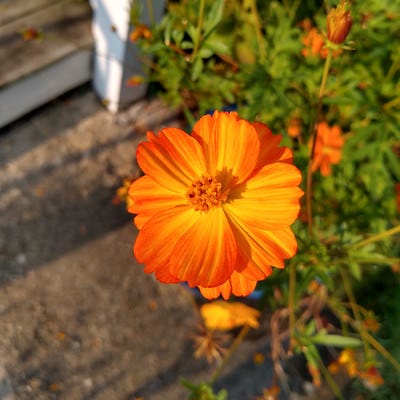This Wheel's on Fire (#6)
Lughnasadh, the Wheel of the Year, why it's not required, & why I do it anyway
One of the first concepts we brush up against when exploring modern witchcraft of pretty much any flavor is the Wheel of the Year. One doesn’t even have to be remotely witchy to have come across the eight major milestones of the solar year: four solstices/equinoxes, and four seasonal mid-points. Ostara, Litha, Mabon, Yule. Imbolc, Beltane, Lughnasadh, Samhain. Honoring the Sabbats is a foundational practice for a broad array of witches, Wiccans, & pagans, and taking time to celebrate these markers throughout the year can be a really satisfying, community-building activity.
But here’s the thing: the Wheel of the Year isn’t ancient. Its celebrations aren’t set in stone. And for the non-theist, non-Wiccan, eclectic weirdo witch, it’s not mandatory.
Image from the Museum of Witchcraft and Magic, Boscastle, Cornwall, UK
There’s a lot that’s already been written & spoken about the uneven and imperfect history of the Wheel of the Year. The deliciously curmudgeonly Trae Dorn has addressed it in his excellent podcast BS-Free Witchcraft (episodes 33 & 57, specifically). Fellow Nerd & Tie podcaster and author Bree NicGarran digs into one aspect of The Wheel’s wobbliness in her magnificent rant on Ostara vs Easter. Here’s a very taught overview of the origins of various parts of The Wheel, highlighting its fundamentally eclectic makeup.
This isn’t to say that there is no value in celebrating various points on The Wheel of the Year; on the contrary, I think its hodgepodge lineage is my favorite part of this broad-ranging tradition, illustrating beautifully the value in playful, ground-up practices.
What I do want to emphasize here is that it’s all made up. The equinoxes & solstices are, certainly, proven astronomical events. But superimposing them over a historically varying set of quarter days and presenting the whole as a calendar of holy Sabbats inked universally onto the fabric of modern witchcraft practices, and broadcast as a necessary and fundamental series of rites, the absolute bare minimum to which to adhere to call oneself a practitioner? Witch, please.
A huge part of my personal practice revolves around observing the natural world and marking its changes throughout the year. And marking the days of The Wheel of the Year is a fun and rewarding part of my witchery. Do I feel the thrill of that first display of Target’s Halloween merch? Am I monitoring my garden for appropriate Lughnasadh blooms? Absolutely. But if my sunflowers don’t sunflower in time, if August 1st lands on a sweltering, overbooked work day as usual, if I can’t manage to carve out the time and energy to observe the day to its fullest, I’m no less of a witch for it.
If you’ve been reading from the start of this low key project, you’ll have picked up on a favorite theme of mine being reiterated here: there are no participation requirements to consider oneself a witch. Active witchcraft can be a delicious, invigorating pursuit adding layers of experience, data, & complexity to our world view. But it is not a mandatory, universal, compulsory undertaking if we are to call ourselves witches.
At its heart, I believe being a witch is about witnessing the world in layers beyond the mundane and routine. The Wheel of the Year can add a welcome framework around which we can build a habit or rhythm of that witnessing. When it becomes a looming obligation, a steady cycle of work to be done rather than an invitation to pause, however, I think it’s worth stepping back and reminding ourselves that The Wheel is a suggestion, not a requisite.
All of this is to say that I don’t want everyone to throw The Wheel of the Year out with the proverbial bathwater. Instead, I want to encourage us all to consider really closely what parts of it actually resonate with our places, spaces & experiences, and what we can add or subtract to make the annual cycle more personal & meaningful to us as witches.
There’s no denying that the traditional correspondences of the various Sabbats are innately tuned to the northern hemisphere’s seasonal shifts, specifically temperate, Western, agricultural and rural rhythms. On one hand, it’s delightfully familiar for someone (like me) with roots in the British Isles, but for a huge population of folks worldwide, The Wheel’s imagery has very little in common with what February, May, or October actually look, feel, & taste like.
So, rather than try & shoehorn our Wheel observances into using materials, plants, foods, & atmospheres that aren’t reflected in our actual experiences of those moments on the calendar, I’d encourage us all to lean into the actual observing part of observances. Take a moment, an hour, a day, whatever you have, and really take stock of what these junctures are like where you are. What is in bloom, what is dying back; what insects & animals are arriving & departing; what does the sky look like, how does the sunlight change; what foods are you craving, and what are you letting go; what is in the shops in abundance this month, and what can’t you find anymore; what are you & people around you wearing, talking about, thinking about, doing with their days that they weren’t a few weeks ago?
Write it all down, or don’t; it’s fun to be able to look back over the previous year and anticipate what you might see again, but it’s not a mandatory part of this practice. Honestly, I use Facebook Memories for a lot of the heavy lifting in my work with The Wheel; it’s amazing to see the patterns that emerge in what I’m thinking about, observing, & choosing to document as the year progresses.
The important part is that we’re taking the opportunity to stop, take note of the progression of time, and witness the changes occurring both around us, & within us. Being a witch means not just existing in the world, but existing with the world, and understanding that duality. Time moves ever forward, and no moment will be exactly the same as the one before, but the sun rising in the east is the same sun that rose yesterday, and last year, and on our ancestors. There’s a comfort in that cycle, in knowing that however much things change, they also circle back to us in time.
So. Take a breath this week of Lughnasadh to pause The Wheel. Put out your hand, let your fingers graze the gently turning spokes, look around and capture this moment in time as it is for you. Feel the sun, breathe the air, listen to the bees or the buses or the busy harbor. Witness the world, as a witch.









I needed the reminder that there are no participation requirements. Thanks for that—
Love this so very much. Thank you 🖤